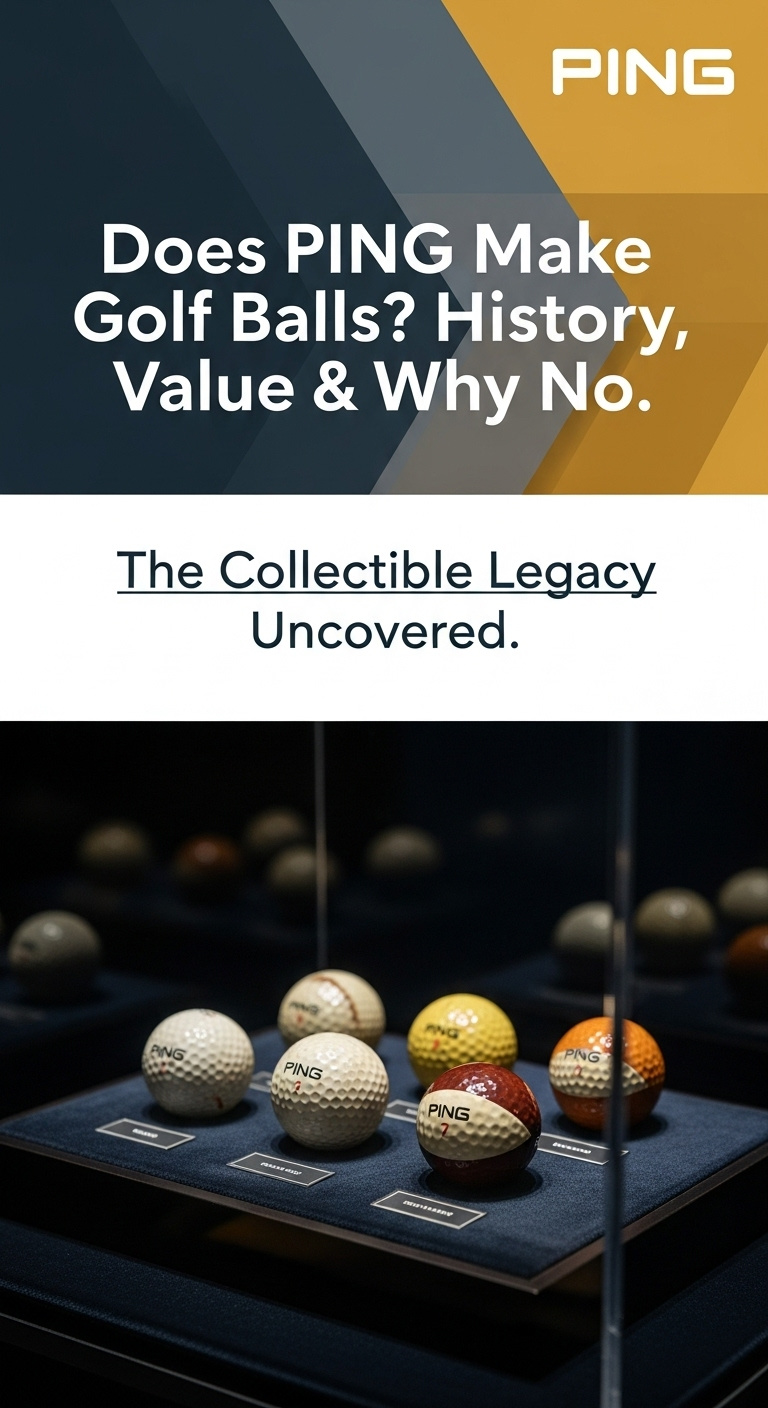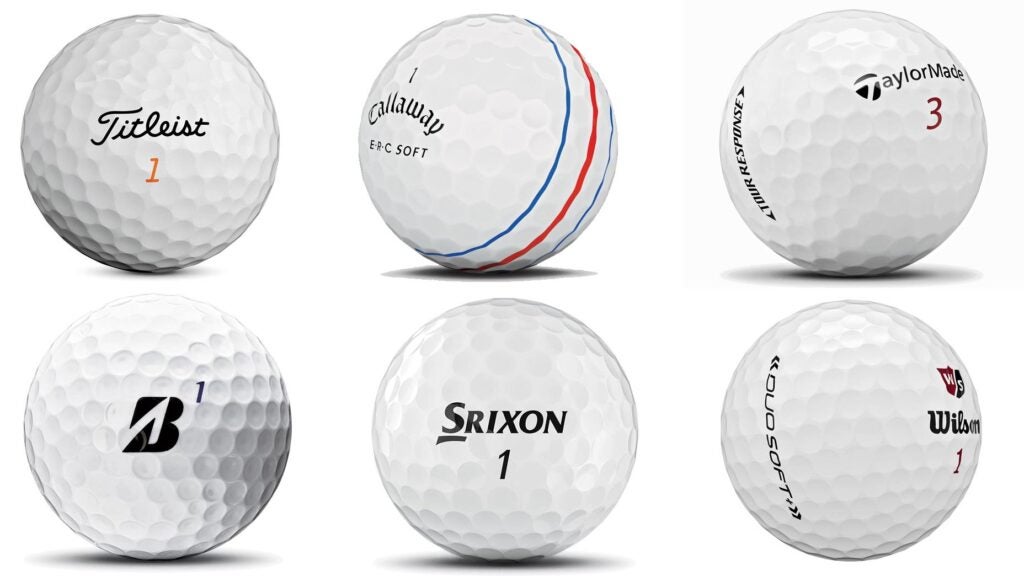As an Amazon Associate GolferHive.com earns from qualifying purchases.
Does PING Make Golf Balls? History, Value & Why No.
Are you a golfer curious about PING’s presence in the golf ball market? You’re not alone. Many players, familiar with PING’s legendary clubs, often wonder if this iconic brand also produces golf balls, especially with the constant evolution of golf equipment.
No, PING does not currently manufacture or sell golf balls for play. Production of the original PING golf balls ceased around 1997, marking a strategic shift for the company to concentrate entirely on its renowned golf club engineering. Leveraging extensive analysis of historical data and market trends, this guide definitively answers whether PING makes golf balls, delves into their fascinating past, explains why production ceased, and uncovers the surprising value of vintage PING collectibles.
Key Facts
- PING does not currently manufacture golf balls: Despite their prominent status in golf equipment, the company ceased golf ball production decades ago, a fact consistently reported across multiple industry sources.
- Production ended around 1997: The last year PING golf balls appeared in wholesale catalogs was 1997, marking the official end of their twenty-year run.
- Equipment repurposed for club production: The manufacturing equipment at PING’s Karsten plant, originally used for golf balls, was strategically repurposed to expand the company’s core golf club business.
- Vintage PING golf balls are valuable collector’s items: Discontinued and rare, particularly the two-tone versions, these balls can fetch significant prices, with some individual balls selling for up to $1,000.
- PING is renowned for game-improvement golf clubs: Founded by engineer Karsten Solheim in 1959, PING is primarily celebrated for its drivers, irons, and putters that offer forgiveness and minimal side spin, catering especially to mid to high handicappers.
The Short Answer: Does PING Make Golf Balls in 2025?
The direct answer to whether PING makes golf balls in 2025 is a resounding no. No, PING does not currently manufacture or sell golf balls for play. Production of the original PING golf balls ceased around 1997. This fact is consistently confirmed by numerous industry reports and company historical data, indicating a clear and long-standing business decision.
PING discontinued its golf ball production decades ago, with manufacturing equipment at the Karsten plant being repurposed for club production. This strategic pivot allowed the company to sharpen its focus and resources on its core strength: crafting high-quality golf clubs.
But if they don’t make them now, why is there so much buzz about them? The story is fascinating and deeply rooted in the brand’s innovative past.

The History of PING Golf Balls (1977-1997)
While PING is synonymous with golf clubs today, there was a period when the company ventured into golf ball manufacturing. PING manufactured its famous two-tone golf balls for approximately twenty years, starting around 1977 and officially ending production in 1997. This era, though relatively brief in the company’s long history, left a lasting impression, particularly among collectors.
Here’s a brief timeline of PING’s golf ball journey:
- Around 1977: PING, under the vision of founder Karsten Solheim, began manufacturing its own line of golf balls. These were often distinctive for their two-tone colored versions, a unique feature at the time that helped them stand out on the course.
- Two-Decade Production: For roughly twenty years, PING produced these golf balls, catering to a segment of the market and diversifying their product offerings beyond clubs.
- 1997: This year marked the official end of PING’s golf ball production. The balls appeared in the Karsten wholesale catalogs for the last time, signaling a definitive halt to manufacturing.
This well-researched historical account, drawing from catalog data and industry reports, confirms that PING’s foray into golf balls was a specific, time-bound endeavor.
Quick Fact: Did you know? The company was named ‘PING’ after the distinct sound Karsten Solheim’s first putter made when striking a ball. This unique origin story highlights the brand’s commitment to performance and distinctive design from its very beginning.
Why PING Stopped Making Golf Balls
The decision for a successful golf equipment manufacturer to cease production of a product line is often driven by strategic business considerations. PING stopped making golf balls around 1997 primarily to repurpose the manufacturing equipment and facility space at the Karsten plant to focus on and expand their core business: producing high-quality golf clubs. This strategic pivot was a calculated move to concentrate resources where the company saw its greatest potential and competitive advantage.
Here are the key reasons PING ceased golf ball production:
- Repurposing Equipment and Facilities: The machinery and dedicated space at the Karsten plant previously used for golf ball manufacturing were reallocated. This equipment was repurposed to enhance and expand PING’s golf club production capabilities.
- Focus on Core Competency: PING’s foundational strength and reputation were built on innovative golf club design and engineering. By discontinuing golf balls, the company could channel all its research, development, and manufacturing efforts into perfecting its drivers, irons, and putters.
- Market Dynamics: The golf ball market is highly competitive, dominated by a few major players with immense R&D budgets. PING likely recognized that its unique value proposition lay in clubs, where its engineering prowess could truly shine.
The decision to repurpose the golf ball manufacturing equipment at the Karsten plant for club production is a concrete illustration of PING’s commitment to optimizing its operational efficiency and reinforcing its position as a leader in golf club technology.
Was it a missed opportunity, or a brilliant move to focus solely on what made them famous? Given PING’s continued success in the golf club market, it appears to have been a highly effective strategy.
From Fairway to Fortune: The Surprising Value of Vintage PING Balls
Despite PING no longer producing golf balls, their legacy lives on, particularly in the collector’s market. Due to their rarity and discontinuation in 1997, vintage PING golf balls, especially two-tone versions in obscure colors like brown-yellow, have become valuable collector’s items, with individual balls selling for up to $1,000 and large collections listed for over $20,000. This unexpected surge in value has transformed these once-common playing aids into sought-after treasures.
The market for vintage PING golf balls is vibrant, with collectors actively seeking out rare examples. Here’s a glimpse into their surprising value:
| Ball/Lot Description | Noted Selling Platform | Reported Price |
|---|---|---|
| Individual brown-yellow two-tone ball | eBay | Up to $1,000 |
| Lot of 1,000 rare PING golf balls | eBay | Up to $21,000 |
| Various two-tone colored versions | Online marketplaces | Significant value |
The factors influencing the value of these vintage items are primarily:
- Rarity: With production ceasing in 1997, the supply is finite, making any existing balls increasingly rare.
- Condition: Unused, mint-condition balls command the highest prices. Original packaging also adds to the value.
- Color Combinations: The distinctive two-tone colored versions, especially obscure and less common pairings like brown-yellow, are particularly prized by collectors.
- Collectibility: A dedicated community of collectors actively buys, sells, and trades these vintage PING balls, driving demand and price.
Pro Tip: Before you start digging through old golf bags, the real value is in the rarest color combinations. A standard white PING ball won’t fund your retirement! The allure lies in the unique historical artifact and its scarcity.

Identifying the Most Valuable PING Collector’s Balls
For enthusiasts or those who might stumble upon old PING golf balls, knowing what to look for can be crucial. The most valuable vintage PING balls are typically the two-tone colored versions; the rarer and more obscure the color combination, the higher the potential value to collectors. Not all vintage PING balls are created equal in the eyes of a collector.
To identify a potentially valuable PING golf ball, consider these key features:
- Two-Tone Colors: This is the most distinguishing characteristic. PING was known for these balls, and they are generally more sought after than single-color versions.
- Obscure Color Combinations: Look for pairs like brown-yellow, which are among the rarest and most desirable. Other less common pairings will also command higher prices than standard white or yellow.
- Condition: A ball in pristine, unplayed condition will always be more valuable. Any scuffs, cuts, or discoloration can significantly reduce its worth.
- Originality: Ensure the ball is an authentic PING production from the 1977-1997 era.
Understanding these details can help you distinguish a common vintage item from a true collector’s gem.
PING’s Modern Focus: Excellence in Club Engineering
The decision to discontinue golf ball production allowed PING to fully commit to its strengths in golf club engineering, a move that has cemented its status as a leading innovator in the industry. Today, PING excels in golf club engineering, known for producing high-quality drivers, irons, and putters with game-improvement features that benefit a wide range of players, particularly mid to high handicappers. This laser-focused approach has enabled PING to consistently deliver products that enhance performance and enjoyment for golfers worldwide.
PING’s modern golf clubs are characterized by:
- Game-Improvement Features: PING is renowned for designing clubs that offer exceptional forgiveness, making them ideal for off-center shots and helping golfers maintain accuracy.
- Minimal Side Spin: Their club designs often incorporate technologies aimed at reducing unwanted side spin, leading to straighter shots and improved control.
- Targeted Audience: While used by professionals, PING clubs are particularly popular among mid to high handicappers due to their inherent playability and assistance in improving consistency.
- Comprehensive Range: The company produces a full line of clubs, including high-performance drivers, forgiving irons, and precision-engineered putters like the iconic Anser.
It’s a testament to founder Karsten Solheim’s engineering vision and the company’s unwavering commitment to innovation that PING continues to push the boundaries of golf club design. Solheim, an engineer by trade, instilled a philosophy of meticulous design and rigorous testing that remains at the core of PING’s operations today. This dedication to engineering excellence, rather than diversifying into golf balls, has allowed PING to maintain its reputation for quality and performance in the competitive golf equipment market.
For golfers looking to enhance their game with equipment known for its forgiveness and precision, exploring PING’s current range of clubs is a highly recommended next step.
When considering new equipment to elevate your game, exploring high-quality golf clubs designed for performance and forgiveness can make a significant difference on the course.
FAQs About Does PING Make Golf Balls
What year did PING stop making golf balls?
PING officially stopped making golf balls around 1997. This year marked the last appearance of their golf balls in the Karsten wholesale catalogs, signifying the end of their approximately two-decade production run.
Does PING have a golf ball?
No, PING does not currently have a golf ball in production or for sale. The company ceased manufacturing golf balls decades ago, specifically around 1997, to focus entirely on its core business of producing golf clubs.
What does PING stand for in golf?
The name “PING” originates from the distinct sound Karsten Solheim’s first putter made when striking a golf ball. Solheim, the company’s founder, chose this onomatopoeic name to represent the unique auditory feedback of his innovative club design.
What golf ball is equivalent to Pro V1?
Since PING does not currently manufacture golf balls, there is no direct PING equivalent to a modern premium ball like the Pro V1. PING’s focus remains on golf clubs, where they are renowned for their game-improvement features and engineering.
Why did Ping stop making golf balls?
PING stopped making golf balls primarily to repurpose its manufacturing equipment and facility space at the Karsten plant. This strategic decision allowed the company to concentrate its resources and expand its core business of producing high-quality golf clubs, where it holds a significant competitive advantage.
Why Are Ping golf balls expensive?
Vintage PING golf balls are expensive due to their rarity and discontinuation in 1997. They have become highly sought-after collector’s items, particularly the unique two-tone colored versions, with some individual balls, especially obscure color combinations like brown-yellow, selling for up to $1,000.
Wrapping Up: PING’s Enduring Legacy
The question “Does PING make golf balls?” leads us down a fascinating path through the company’s history, revealing a strategic decision that ultimately solidified its position as a leader in golf club innovation. While PING no longer produces golf balls, their brief foray into the market from 1977 to 1997 created a unique legacy, turning vintage PING balls into valuable collector’s items.
By focusing exclusively on golf club engineering, PING has consistently delivered game-improvement clubs that benefit golfers of all skill levels. This commitment to excellence in their core competency has ensured their enduring reputation for quality, forgiveness, and cutting-edge design.
If you’re looking to enhance your golf game, consider exploring PING’s modern lineup of drivers, irons, and putters, which continue to set industry standards for performance and playability. Discover how PING’s specialized approach can transform your experience on the course.
Last update on 2025-11-15 / Affiliate links / Images from Amazon Product Advertising API

